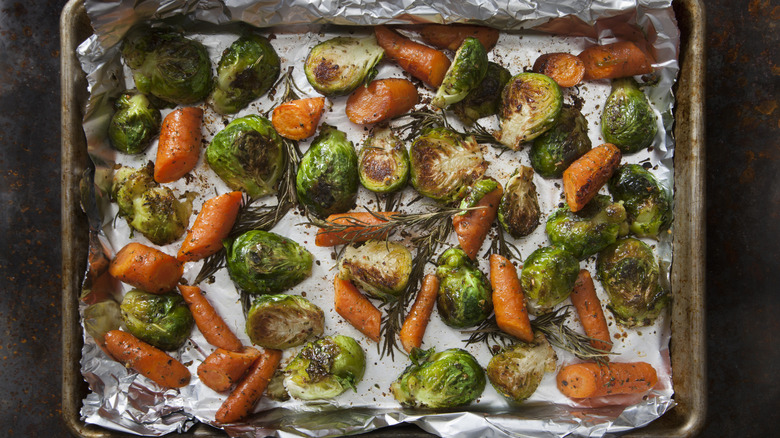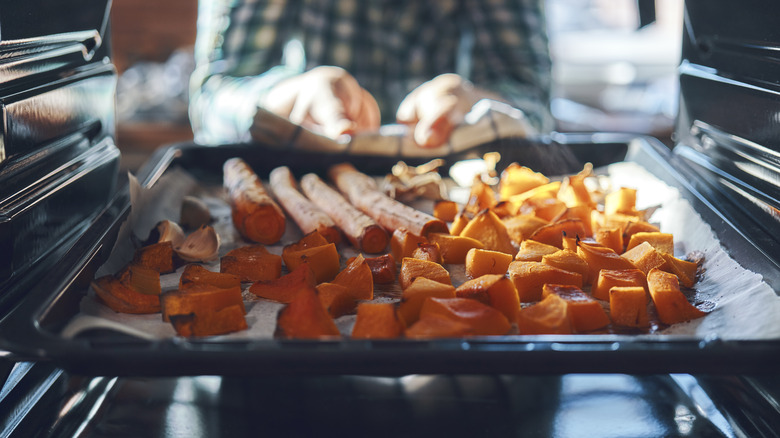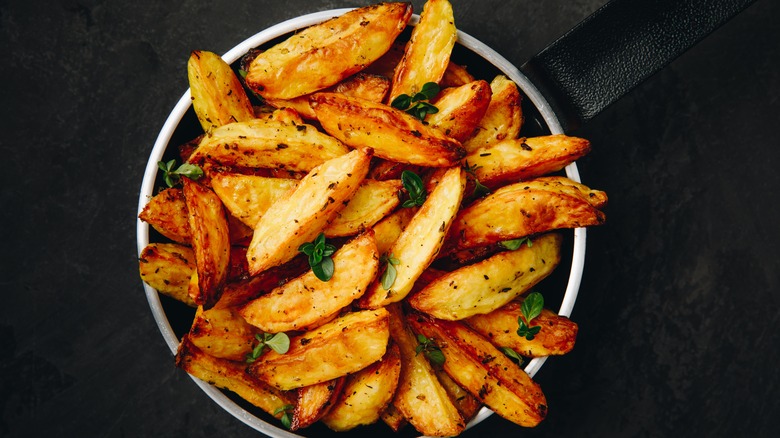A Little Cornstarch Makes Roasted Vegetables Unbelievably Crispy
Roasted vegetables make a delicious addition to any meal, be it a tender or crispy roast chicken or a healthy lunch recipe. How you cook your vegetables can make all the difference; the tastiest roasted vegetables are full of flavor and appeal to even the pickiest of eaters.
Despite your best efforts, however, sometimes roasted vegetables turn out soggy or floppy — and they're not as delicious as you hoped. The secret to the crispiest roasted vegetables is something you probably already have hanging out in your pantry: a bit of cornstarch. Cornstarch is pure starch that comes from corn, and its high concentration of amylose aids this substance in crisping up your vegetables during the roasting process. Amylose is a molecule found in starch, which leads to crispiness because it compresses and gets rigid as it cooks. Cornstarch can also do double duty by absorbing excess water; too much water can make vegetables soggier. As cornstarch heats up, the molecules get bigger and can absorb more moisture.
To get a nice crisp on the outside of your vegetables, mix cornstarch with either water or vegetable oil, then toss your vegetables in it. The extra starch will react to the heat as the vegetables cook, leaving them crispy on the outside and soft and tender on the inside.
Make the most of cooking with cornstarch
Beyond roasting vegetables, cornstarch is often used as a thickening agent for gravy, stews, and sauces. Therefore, this versatile pantry ingredient is one you should always have on hand. Cornstarch helps make crispier chicken and works for other proteins, too.
When it comes to roasting vegetables, the starch naturally present in some, such as potatoes, helps achieve a crispy coating without extra ingredients. However, many vegetables don't contain a high enough starch content, so they can get quite limp and floppy after being roasted. Even when it comes to potatoes, the extra starch can help.
As that extra starch on the outside firms up during the cooking process, the cellulose and pectin naturally present in the vegetables soften, creating the crisp exterior and naturally soft, tender interior you want to achieve. Plus, this trick can work for any type of vegetable. Try it with potatoes, carrots, yams, or broccoli to get a more satisfying crunch when you take a bite.
How to use cornstarch on roasted vegetables
Adding cornstarch to your recipe to make crispier roasted vegetables is simple and quick — and shouldn't add more than a few minutes to your prep time. After washing your vegetables, pat them dry; this helps remove any extra moisture and helps ensure the cornstarch will stick evenly.
Then, try one of two methods: Mix cornstarch and water and stir vigorously until you have a batter-like consistency, or mix cornstarch with vegetable oil. Both methods should yield similar results, but make sure you combine the cornstarch with something. If you don't, you could end up with powder on your vegetables after they finish cooking. The general rule is to aim for about 1 tablespoon of cornstarch per pound of vegetables.
Once you have your mixture, toss in your vegetables and make sure they are evenly coated. From there, follow your recipe as usual; most call for roasting vegetables at high temperatures — around 400 degrees Fahrenheit or higher — for 15 minutes or more, depending on the type and size of your vegetable. You'll know your roasted vegetables are done when they're nice and crispy on the outside and soft and tender on the inside.


